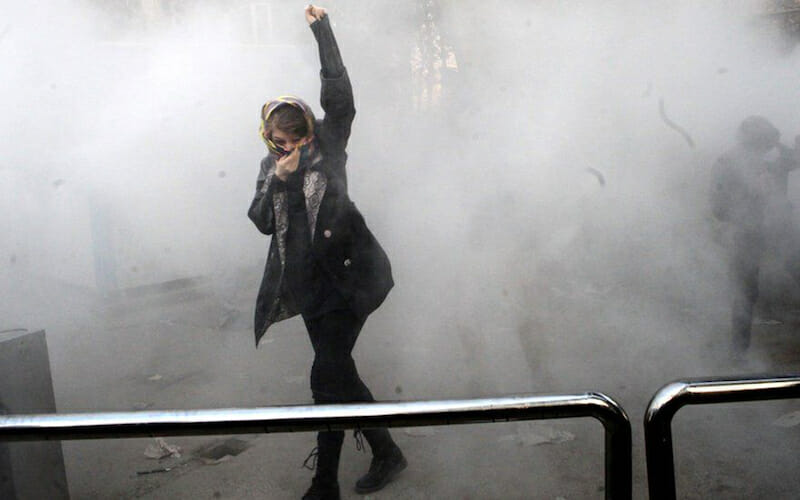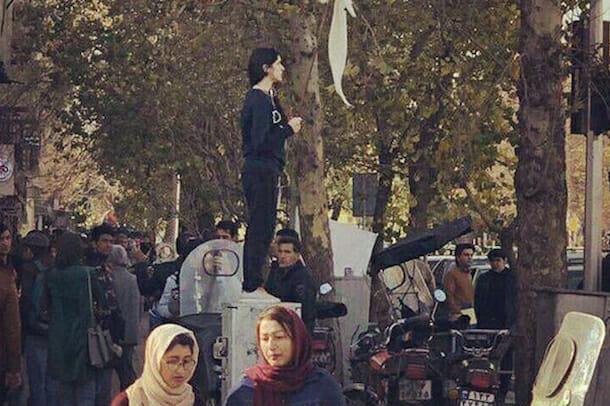
Even before Trump’s Latest Warning, Iran was Facing Bigger Problems than Ever
In a press conference during his French counterpart’s visit to the Oval Office, President Donald Trump issued a stark warning to the Islamic Republic of Iran. If they restart their nuclear program, he said, “They will have bigger problems than they’ve ever had before.” The warning was notable, not simply because the White House may reinstate sanctions that were suspended under the 2015 nuclear agreement or withdraw from the deal altogether, but because of the historic rebellion underway in Iran.
There is a strong argument to be made that the Islamic Republic is facing bigger problems than they’ve ever had before. The regime is struggling to stabilize its currency in the midst of an economic crisis that caused the rial’s value to fall in April to roughly half the value it enjoyed the previous September. This is a threat in and of itself but it is made worse by persistently poor economic indicators that are certain to exacerbate an already emboldened protest movement – one that has spanned the country and remained active since the end of last year.
In December, the first public gatherings took place in the city of Mashhad in the face of growing poverty and runaway inflation. Very quickly, though, the demonstrations turned more political and more confrontational, with participants recognizing that their problems could never be seriously addressed by the existing regime. By mid-January, these protests had expanded to every major town and city in Iran as the people publicly rejected both the “hardline” and “moderate” factions of Iranian politics and chanted slogans like “death to Khamenei” and “death to Rouhani,” in reference to the supreme leader and president, respectively.
The nationwide uprising was temporarily suppressed by Iranian security forces and the Revolutionary Guard Corps, but not before Supreme Leader Ali Khamenei broke with his regime’s usual tactics of propaganda, acknowledging that the principal Iranian Resistance group, the People’s Mojahedin Organization of Iran (PMOI/MEK), had played a leading role in planning and organizing the demonstrations. About two and half months later, the Iranian opposition leader Maryam Rajavi promised more to come, delivering a speech at the Iranian New Year that called for the year ahead to be “a year full of uprisings.”
It was not immediately clear what Donald Trump meant when he threatened Tehran with bigger problems than ever before. But if he wants to strike a fatal blow to the regime, he can specify that his administration will take immediate actions to support Iran’s domestic resistance movement. He can start by sanctioning the Iranian institutions and individuals responsible for a series of reprehensible crackdowns on freedom-seeking demonstrators.
Trump could make the threat even more credible by urging European leaders to enlist support from their governments regarding this and other measures. In contrast to the discord over the nuclear agreement, there is every reason to believe that the US and Europe are capable of seeing eye-to-eye on this and other such policies. Although France, Germany, and the UK continue to stand by a deal that Trump has called the “worst ever,” those same nations have increasingly sounded the alarm in recent weeks over Iran’s ballistic missile program and its destabilizing effect on the broader Middle East.
Emmanuel Macron, the French president, underscored this alignment of American and European views by saying that both leaders would look at the Joint Comprehensive Plan of Action “in a wider regional context.” Other world leaders should do the same.

It is increasingly clear that not only do Western governments share a mutual security interest in curtailing Tehran’s violent arc of influence but the unrelenting protests facing the regime make it obvious that the aspirations of the Iranian people struggling for freedom share this cause too.
One of the most prominent slogans from the January uprising called upon the Iranian government to “forget about Syria; think of us.” Insofar as both Trump and Macron made apparent commitments to broad-based action in their meetings, the clearest way for them both to live up to these commitments is to support the Iranian people in their endeavors to turn the regime’s attention inward.
By supporting the MEK and other pro-democracy groups inside Iran, the US and France can work together to make progress toward another mutual commitment: avoiding the mistakes of the past.
“France is not naive when it comes to Iran,” Macron said last week. “But we do not repeat the mistakes of the past.” On January 2, he demonstrated this was more than mere rhetoric by rebuffing Iran’s President, Hassan Rouhani, who called on him to urge a crackdown on the French headquarters of the National Council of Resistance of Iran, the coalition of pro-democracy dissidents, led by Maryam Rajavi, of which MEK is the main constituent.
In his own reference to past mistakes last Tuesday, President Trump not only singled out the Obama White House but vowed that his administration “will not make the mistake of past administrations,” implicitly acknowledging that flawed policies toward Iran have been a perennial problem in American politics.
The worst outcome of these ineffectual policies was the marginalization of the Iranian Resistance based on false narratives about the stability of the clerical regime and the absence of a viable alternative. But recent protests belie that narrative and make it clear that the Iranian regime is far from stable and even vulnerable to collapse as it faces a restive populations seeking regime change from within. With discontent on the Iranian street reaching a fever pitch, there has never been a better time to leverage the uprisings to push back on Iranian belligerence.
While some analysts in Washington predicted that the protests would be short-lived, they show no signs of slowing. A careful review of the evidence indicates that the protests marked a turning point and a permanent change in the trend of events and political calculations in Iran.
By exploiting the internal threats already consuming Tehran’s attention, the White House can truly ensure that future Iranian misbehavior – not just in the nuclear sphere – results in the regime facing “bigger problems than they’ve ever had before.”

